It's hard to project 10 years into the future, but let's do it anyway. Who are the young stars in position to lead the league for the next decade? And who are the dark horses that should be considered?
A year ago at this time, we were preparing to send off the 2010s. As we were getting set for one last season to put the finishing touches on our All-Decade Teams, I took a look at which players were leading various statistical categories, to see if any were still up for grabs.
Turns out some were. Most notably, Antonio Brown torpedoing his 2019 cost him the league lead in both receptions and receiving yards for the decade.
Now, as we stand at the dawn of a new decade of numbers to tally, I thought it would be fun to look a little further into the future. Let’s take some guesses at who will find themselves atop these same categories for the 2020s. And as an added bonus: Before making my guesses for the 2020s, I’ll go back in time and think about who I would have picked if I had been doing this exercise in 2010.
I anticipate getting everything right, of course, so please hold all hate mail until 2030.
Passing Yards
Past Leaders:
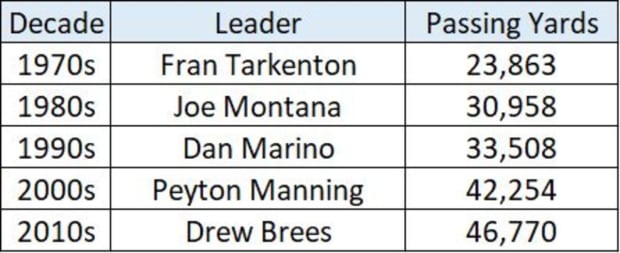
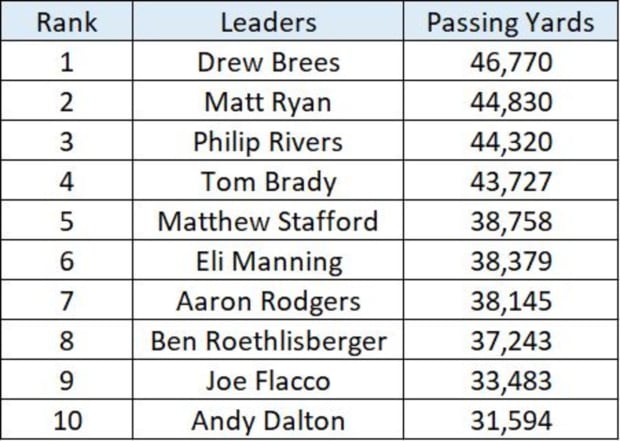
2010s Pick:
Drew Brees didn’t quite lead wire-to-wire in passing yards, because he finished 90 behind Philip Rivers (and 80 behind Peyton Manning) in 2010. But he then led the league in five of the next six seasons to take over. He definitely would have been in the conversation in 2010, especially since that offseason followed his Super Bowl win the previous February. But I don’t think he would have been the obvious pick. Brees was going into his age-31 season, and one of the major changes of this last decade is the way we view quarterbacks approaching and surpassing their 40th birthdays. At the time, it would have been hard to foresee him missing just two games total until his first substantial injury this past season.
Eight of the top 10 QBs in passing yards in 2009 were 28 or older (including 2009 passing yards leader Matt Schaub, a fact that could definitely win you a trivia night someday). The two younger players: Ben Roethlisberger (then 27) and Aaron Rodgers (26). I think Rodgers would’ve been the likely pick. He had just completed his second year as a starter, topping 4,000 yards for the second time, and had been selected to his first Pro Bowl. That’s a stronger resumé than some of the even younger players, like Matt Ryan (who actually finished second this decade), Matthew Stafford or incoming top overall pick Sam Bradford.
2020s Pick:
Let’s not overthink this too much. If you wanted to invent your dream candidate from scratch, you’d pick a 25-year-old with unbelievable tools, a great offense to play in and both an MVP season and a Super Bowl MVP under his belt. Patrick Mahomes is that guy. The Chiefs have already signed him to a contract extension that covers the entire next decade and then some. We know players often don’t make it to the end of their contracts without being cut or renegotiating, but it underscores the point that they expect him around for the long haul. They anticipate more 5,000-yard seasons to come, and so can we.
Now, Mahomes’s numbers did dip last season, partly because of time missed with an injury, but also on a per-game basis. So if you want to pick somebody else, we should at least discuss the candidates. Dak Prescott is only 27, and finished second in the league with 4,902 yards last season. It’s impossible to predict durability a decade into the future, but Prescott’s track record of playing all 64 games the last four years is a good sign. A year ago, when his career high was still under 4,000 yards, I might not have picked him. But now we’ve seen a higher statistical ceiling, and we know that he will have a great wide receiver room if he stays in Dallas beyond this franchise-tag year. Other candidates: Deshaun Watson is still somehow just 25. Expectations are through the roof for Kyler Murray going into his second season. Jared Goff had his second straight 4,600-yard season, even in what everyone considered a down year. I’d avoid picking anyone already in their 30s, but Russell Wilson is 32 and claims he can play into his mid-40s. I’m more open to that idea now than I would have been a decade ago.
Dark horse candidate: It’s hard to have a true dark horse among starting NFL quarterbacks because every one of these guys is analyzed so much. People are already going to be mad that I left out QBs from the paragraph above. I guess if you had to go truly off the board, you could take … presumed 2021 top draft pick Trevor Lawrence. He’s at a significant disadvantage to be starting his NFL career a year late, but if enough guys in front of him miss time, he could catch them. But if you want to bank on an unknown, I’d rather take Joe Burrow—a guy who also put up incredible numbers in college and is also, you know, an NFL quarterback in 2020.
Passing Touchdowns
Past Leaders:
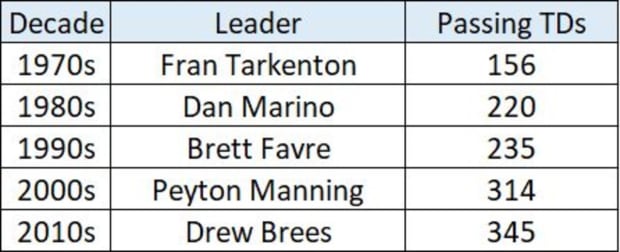
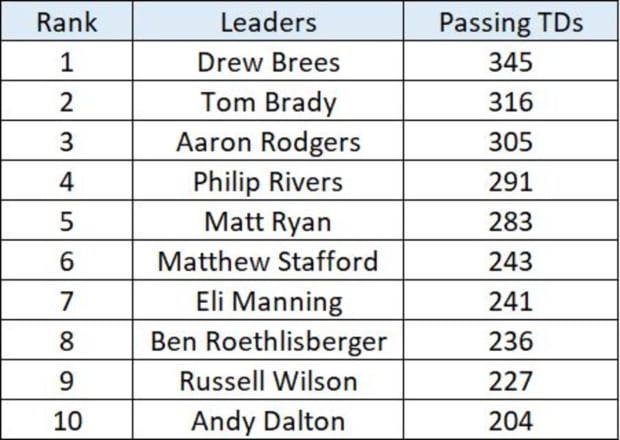
2010s Pick:
The names atop this list are very similar to the passing yards leaders, so I won’t repeat myself too much. I think Aaron Rodgers again would have been the pick, for the same reasons stated above. Though Philip Rivers, who led the NFL with 34 in 2008 and was second to Brees in combined TDs between 2008 and 2009, could have been in the mix too.
2020s Pick:
Again, it seems a little silly to pick anyone but Patrick Mahomes here. He may even be more likely to lead the NFL in touchdowns than yards. In 2018 he threw TDs in such bunches, that you’d think he can still get his touchdowns even if he misses time some years and the yards aren’t quite there. Then again, he only had 26 TDs last year, tied for eighth in the league, so we have to consider other players.
Here’s where I’ll mention reigning MVP Lamar Jackson, who led the league in touchdown passes last year with 36, even though he was just 22nd in passing yards (3,127). And that makes sense. The Ravens had a historic rushing attack, which obviously he was a part of. So they scored a ton of touchdowns last year. And whether Jackson marched them down the field with his arm or his legs, he had plenty of opportunities to throw the ball into the end zone. It’s possible his style will evolve over the next 10 years (It’s likely! Ten years is a long time!) but I’m not ready to project him as the passing yards leader for a decade. But as long as he’s great, however he does it, he could keep racking up touchdowns.
Dark horse candidate: Again, there’s no such thing as a real dark horse among NFL starting quarterbacks. Want to project a Hall of Fame career for Sam Darnold, Josh Allen, Daniel Jones, Drew Lock or Gardner Minshew? Be as optimistic as you want. At least one of them will probably be high on all these lists 10 years from now. Think Carson Wentz will be healthy enough to rack up these stats? Your call. Want to project Matt Ryan playing until he’s 44? Go for it. But if you need a total dark horse, you can say Jameis Winston. He’s only 26, and he did lead the league in passing yards and finish second to Jackson in TDs last year. If something happens to Brees and Winston lands in the middle of a great Saints offense in 2020, it could lead to a second act during his prime years. I wouldn’t advise picking a current NFL backup, and I don’t expect it to happen, but that’s why he’s in the dark horse section.
Rushing Yards
Past Leaders:
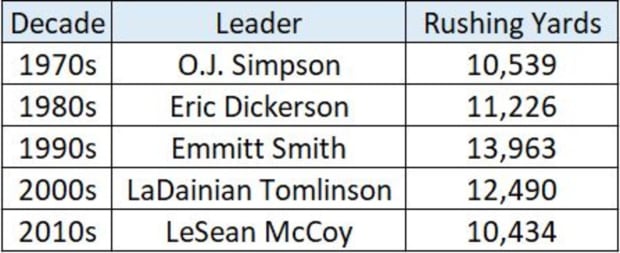
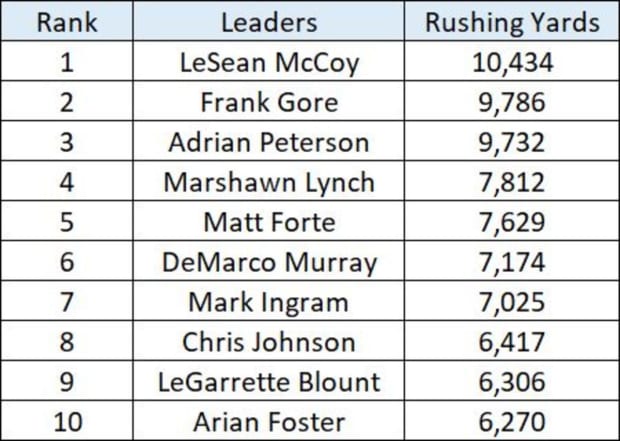
2010s Pick:
Running back is a much tougher position to project because it’s so hard to have a long career and often harder to know who will do it. The four players at the top of the 2010s decade list all played in both 2010 and 2019: LeSean McCoy, Frank Gore, Adrian Peterson and Marshawn Lynch (who retired twice along the way). But nobody else was a feature back for the whole decade.
Adrian Peterson would have been the safe pick going into 2010. We all knew how good he was at Oklahoma, when he went seventh overall in the draft and when he won Offensive Rookie of the Year in 2007. He was then an All-Pro in 2008 and ’09, with a rushing title that first year, and was 25 entering 2010. But there were other candidates. That ’09 season was the year Chris Johnson became CJ2K, and he was both the same age as Peterson and had fewer years of hits on his body in the NFL.
The other top option would’ve been Ray Rice, who rushed for 1,339 yards as a 22-year-old in 2009 and then starred in the Ravens’ playoff win at New England that January. Of course, we now know his career was derailed by a domestic violence suspension and he never played again after 2013.
2020s Pick:
Again, age is just as important as talent here. The top 12 rushing yardage leaders in the league last year were all 25 or younger. It’s reasonable to expect the top group will be just as young five years from now, which means the current backs will slow down and new ones will rise to replace them. We’ve seen plenty of superstar running backs fall off a cliff much sooner than anyone could have expected and you have to assume it’ll happen to the current stars in the league at some point too. Some of them may be the next Frank Gore or Adrian Peterson, but we don’t know who.
I’ll play the odds and take Saquon Barkley, even though he missed time last year with a high ankle sprain and finished only 16th in the league with 1,003 yards. He’ll be 23 this year, younger than Ezekiel Elliott (25), Nick Chubb (25) and Derrick Henry (26). Those three all seem built to withstand some punishment and produce into their 30s, but those extra years could be significant when talking about any of them still being starters in the 2028 and 2029 seasons. Christian McCaffrey of course deserves to be on the list. He’s 24 and would be a smart pick to lead the league in yards from scrimmage for the decade. But because he’s not as big, and so good in the passing game, I could see him being complemented by a bigger back at some point in his career, while I could see Saquon and Zeke getting more carries for longer into their careers.
If you made age the most important factor, you could make a case for Josh Jacobs, who had 1,150 yards last year in 13 games as a 21-year-old, but I’ll stick with Saquon.
Dark horse candidate: What if I told you that last year there was a 22-year-old who finished sixth in the league with more than 1,200 rushing yards? What if I told you he took over as a starter midway through 2018 and he averaged 80 yards per game in the 22 weeks since then? You’d probably want to know more about him, right? Well… uhh… his name is Lamar Jackson. And it’s a little weird to think about a quarterback leading the league in rushing yards for a whole decade, but maybe in this case it shouldn’t be. I wrote above about what a short shelf-life most running backs have. If Jackson continues to be a star, he’s much more likely than any of the running backs I mentioned to still be a starter in 2029. It’s possible his style will evolve as he ages—either because he becomes better as a passer or because every young, mobile quarterback eventually gets to the point in their career when everyone starts telling them they need to run less and take fewer hits. But what if this is just who Lamar Jackson is for his whole career? Even if he gives us just three or four more seasons in that 1,000-1,200 range (I say “just” even though that would be a historic output), a graceful decline to 600 or 700 yards through the back end of the decade could still put him in lofty territory. It’s more than possible that Lamar Jackson puts up a 4,000-yard passing, 600-yard rushing season (or better!) as a 32-year-old in 2029 after guys like Joe Mixon and Dalvin Cook are out of the league.
Rushing Touchdowns
Past Leaders:
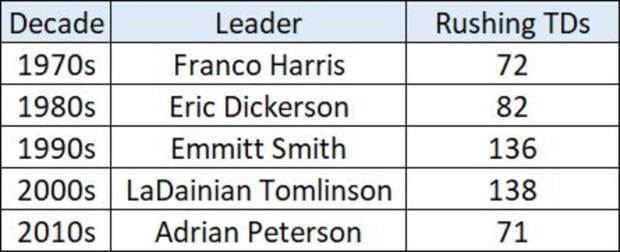
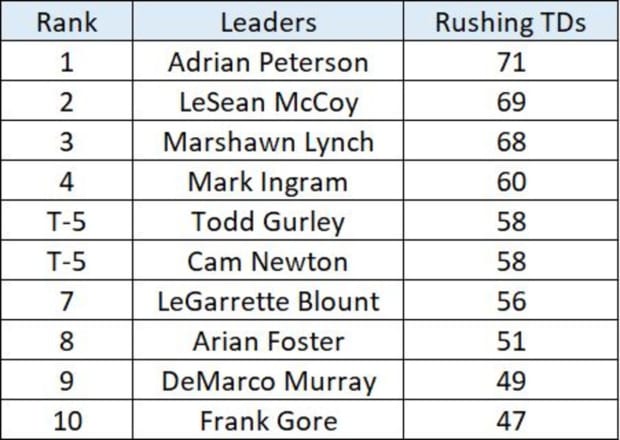
2010s Pick:
Again, the names here are very similar to the ones we saw in the rushing yards section. The difference here is that I think Adrian Peterson would have been even more of a lock to pick this time. In 2009, he led the NFL in rushing touchdowns for the first time with 18, three more than Maurice Jones-Drew, and four more than the aforementioned rushing champ Chris Johnson and a 31-year-old Thomas Jones. Turns out that would have been a good pick, as Peterson did lead the decade in rushing touchdowns, overtaking Lynch and fending off McCoy last season.
2020s Pick:
The names are similar here too, though now I’ll mention Aaron Jones (who tied Henry with 16 scores last year). Although I think a player with a high peak and a little less longevity would be more likely to lead in touchdowns than yards. So this time I’ll go with Ezekiel Elliott. Fantasy players may remember that he only had six touchdowns in 2018. But he scored 15 as a rookie in 2016, rebounded with 12 last year and plays in an offense that should keep scoring touchdowns if the Cowboys keep their current core together.
Receptions
Past Leaders:
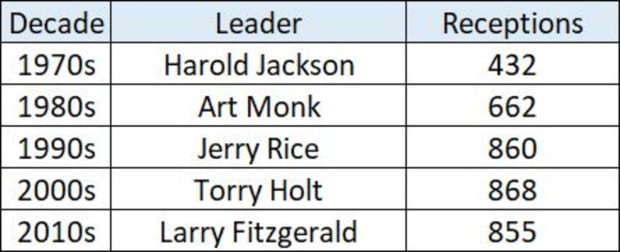
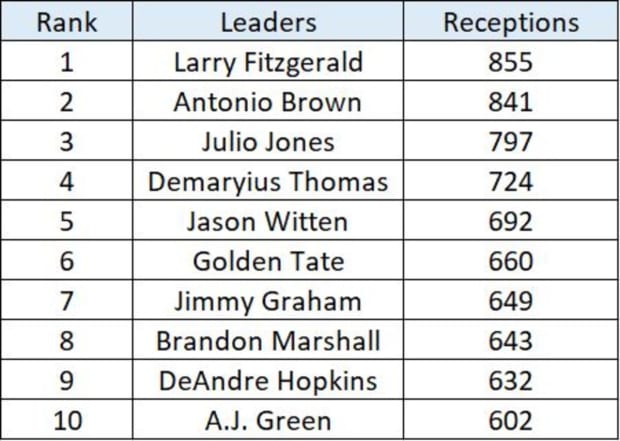
2010s Pick:
Larry Fitzgerald was certainly good enough to be chosen here. The eventual winner had back-to-back 1,400-yard seasons in 2007 and 2008, then looked like the best football player in the world carrying the Cardinals to the Super Bowl in February 2009. He followed that up with 97 grabs, his third straight season with between 96 and 100. But 27 years old may have been past the outer reaches of who we would have considered. Younger players around him on the leaderboard included Brandon Marshall, a year younger and fresh off his third straight 100-catch season for the Broncos, and Steve Smith—the one on the Giants, who had 107 catches in 2009 and then 73 combined in the three remaining years of his career (I think we would have picked a player with a stronger track record). Calvin Johnson’s numbers were down across the board as a 24-year-old in 14 games during Matthew Stafford’s rookie season (67 catches, 984 yards, five touchdowns). But his age, pedigree and physical gifts still could have made him a candidate if we believed in Stafford getting better. (Johnson also could have run away with a few of these categories if he hadn’t retired at age 30 in 2015.) I’ll go elsewhere for yards and touchdowns, but I think Brandon Marshall’s age and consistency topping the 100-catch plateau would have made him the guy here.
2020s Pick:
There are too many great wide receivers in the NFL right now. It’s tremendous fun every time there’s a game on TV, but it makes for an inconvenience right now. All summer I watched people get torched for sharing lists of the best 10 or 20 receivers in the league and leaving out somebody who seems deserving until you actually sit down and rank them all.
I actually think there’s something to the fact that so many guys on the 2010s leaderboards didn’t enter the league until the decade was underway. The league just keeps becoming more pass-happy each year, due to a combination of rule changes, scheme evolution and more. As incredible as some of today’s top players may seem, it’s possible that the superstars dominating five-to-eight years from now exist in an even better environment. So this is a position where it makes sense to go really young. And yes, I’m willing to include some of the star receivers at the top of this year’s draft.
So I’m just cutting anyone going into 2020 at age 26 or older. Goodbye Julio Jones, DeAndre Hopkins, Tyreek Hill, Mike Evans, Davante Adams, Stefon Diggs, Amari Cooper, Keenan Allen, Odell Beckham, Jarvis Landry, Robert Woods, Davante Parker, George Kittle and, yes, even Michael Thomas.
Who’s left? Based on track record and my own personal projections, the pool includes this year’s rookies and (ages for the upcoming season) 23-year-olds A.J. Brown and D.J. Moore; 24-year-olds D.J. Chark and Chris Godwin; and 25-year-olds Terry McLaurin and Courtland Sutton.
For receptions, I’m taking CeeDee Lamb. I know it’s a risky decision to take a player who has never lined up against an NFL defense in even a preseason game, but I’ll take my chances. I think he has the potential to be a monster, and he starts his career in a very good offense and—come on—you have to assume Dak Prescott won’t walk out of Dallas after one more year. I know Henry Ruggs and Jerry Jeudy were drafted ahead of him, but Lamb is the one I think will be a terrifying threat who sucks up targets in the mold of Julio Jones or Michael Thomas.
Dark horse candidate: Christian McCaffrey! I already picked a quarterback for rushing yards, so why not pick a running back for receptions? I know I’ve gone on at length about the short shelf-life for running backs. But CMC is still going into just his age-24 season. He caught 116 balls last year, after 107 the year before. He can still be a target monster, and it’s possible he becomes even more involved in the passing game as he ages if that’s somehow seen as a way to utilize him as a weapon without running him into the line 15-20 times a game. Apologies to all the wonderful wide receivers who got snubbed.
Receiving Yards
Past Leaders:
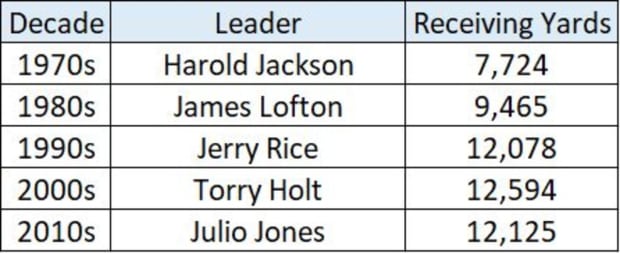
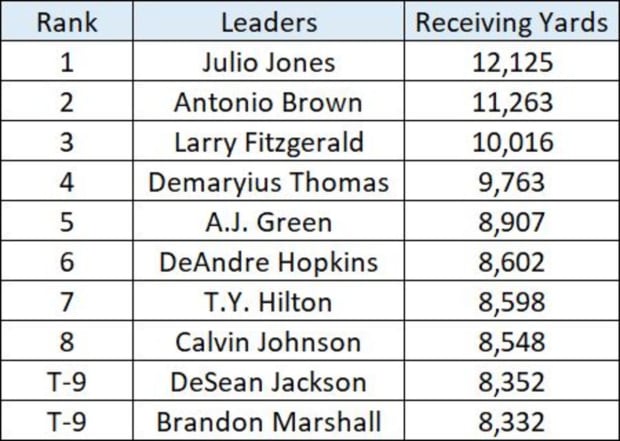
2010s Pick:
As I mentioned above, it’s interesting how many of the top wide receivers on this list hadn’t entered the league yet, and it’s particularly evident here—everyone in the top seven except Fitzgerald. Sidney Rice had his magical 1,312-yard season as a 23-year-old playing with Brett Favre, but he was far from proven. Miles Austin similarly had his breakout in 2009. DeSean Jackson had 2,000 yards between his first two seasons, but I probably would’ve been hesitant to pick a smaller player that reliant on speed. Santonio Holmes caught 1,248 yards as a 25-year-old and had already established himself as a Super Bowl hero. But I like to think I would have been smart enough to pick Calvin Johnson, despite his dip in 2009. I mean, look at the guy. His 70 yards per game projected to more than 1,100 if he’d played all 16 games. And the former No. 2 overall pick’s incredible prime was not exactly a shock after he’d hauled in 1,300 yards and tied Fitz for a league-leading 12 TDs in 2008.
2020s Pick:
Again, there are so many options it’s hard to feel good about any of them. It’s tempting to take Lamb again, for all the reasons listed above. But if I’m throwing a dart, this time it’s landing on Chris Godwin. His breakout 2019 season was widely predicted and he very much delivered, with 1,333 yards before missing the last two weeks. He’s 24 and ready to enter his prime. It’s a bit concerning that I don’t know what his QB situation will look like after Tom Brady’s time in Tampa is over, but Godwin is a stud at the right spot in his career to claim this decade.
Dark horse candidate: Ja’Marr Chase. I’ve spilled too much ink on the possibility of a guy arriving late to the party and lapping the field anyway. So give me Chase for my dark horse. The LSU receiver has opted out of the 2020 season and is likely going to be the first wideout drafted in 2021. Last year he set SEC records with 20 receiving touchdowns and 1,780 receiving yards. Who’s to say he can’t spot everyone a year and still come out on top? Not me.
Receiving Touchdowns
Past Leaders:

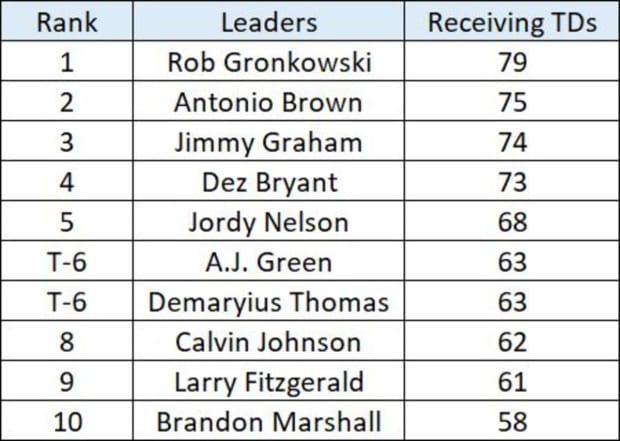
2010s Pick:
Here’s where I think Fitzgerald would have been the guy. Everyone knew how good he was. He led the league in touchdowns in each of the two previous seasons (along with nine touchdowns in six playoff games during that span). Even though he was a little older and Kurt Warner had retired, Fitz seemed capable of catching touchdowns from anyone—which proved mostly true during the frustrating QB search that followed.
2020s Pick:
Give me A.J. Brown here. He was too good down the stretch last year not to pick him for something. I like his ability to get in the end zone from anywhere on the field, and he had nice balance last year with four of his receiving touchdowns coming on scores of 50-plus yards and four coming from inside the red zone. He plays in a running back-centric offense now, but that won’t be the case for his whole career. And who knows if that even hurts him.
Dark horse candidate: Again, like the quarterbacks, it’s hard to have a dark horse when so many of the top guys are examined and dissected so much. Hardcore fantasy players could rattle off the top 100 receivers, including a bevy of deep sleepers. So maybe the answer here is a tight end? Gronk did lead the pack for the 2010s, after all. Mark Andrews had 10 touchdowns as a 23-year-old, and you can make a nice living as a big-time red zone threat in a good offense.
Sacks
Past Leaders:
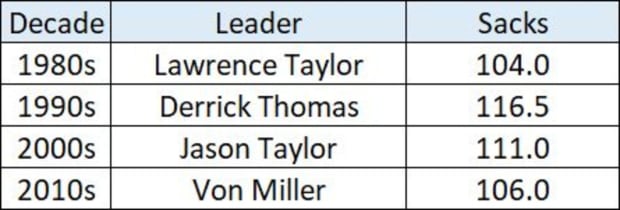
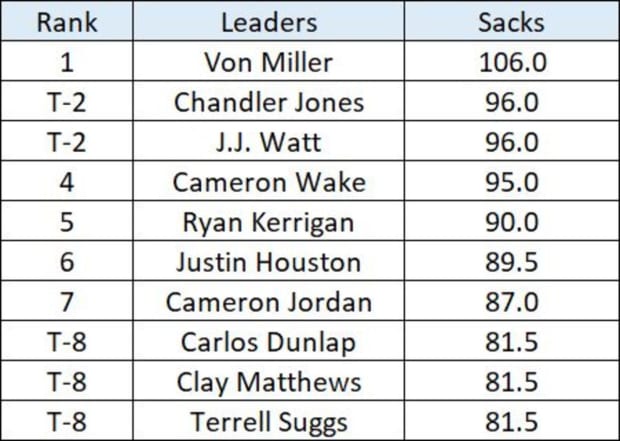
2010s Pick:
Von Miller would not have been your pick in 2010. He was coming off a 17-sack season, but did so as a junior at Texas A&M. He then returned to College Station for his senior year and didn’t start compiling sacks in the NFL until 2011. Proof that any of these categories could still be taken over by players we’re not thinking about.
Elvis Dumervil led the NFL with 17 sacks as a 25-year-old in 2009, but tore his pec in early August and missed all of 2010. Former top overall pick Mario Williams had finally started putting up sack totals, with 12 in his age-23 season (2008) and nine the next year. But I think the search for an up-and-coming young player could have landed on Clay Matthews. The USC star with an NFL pedigree was drafted 26th by Green Bay, and then he piled up 10 sacks and made the Pro Bowl as a 23-year-old rookie in 2009. As it happened, he finished tied for eighth for the decade and Cameron Wake is the only player above him on the list who was also already in the league in 2010. Miller, J.J. Watt, Ryan Kerrigan, Justin Houston and Cameron Jordan all debuted in 2011 and Chandler Jones arrived in 2012. So Mathews was a good pick among the options you would have seen coming in 2010.
2020s Pick:
Even with all the info above, I think I’ll go with a young NFL star rather than scout college juniors. There are seven players who registered double-digit sacks last season in age-25-or-under seasons, including guys like Joey Bosa and 2017’s top pick, Myles Garrett, who had 10 in just 10 games (thanks to his lengthy suspension). But I’m going to pick Bosa’s younger brother Nick Bosa, who had nine sacks for San Francisco as a 22-year-old rookie. I just think he was born and bred to sack NFL quarterbacks and I’ll bank on his age 30-32 seasons closing out the decade instead of his slightly older brother. Very few players older than 35 had seasons with five or more sacks last decade, so that youth now helps.
Dark horse candidate: There are two players as young as Nick Bosa who had more sacks than him last year—Josh Allen (10.5) and Maxx Crosby (10.0)—but I don’t think either counts as a dark horse after those seasons. A better way to find a dark horse might be to predict this decade’s Julius Peppers/Terrell Suggs/James Harrison who can keep playing until he’s 37. Maybe that player is 29-year-old Khalil Mack? Just because he’s Khalil Mack and why would you want to pick against him? But clearly some of the younger players are safer bets.
Interceptions
Past Leaders:
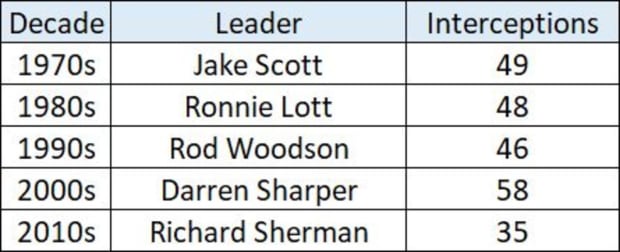
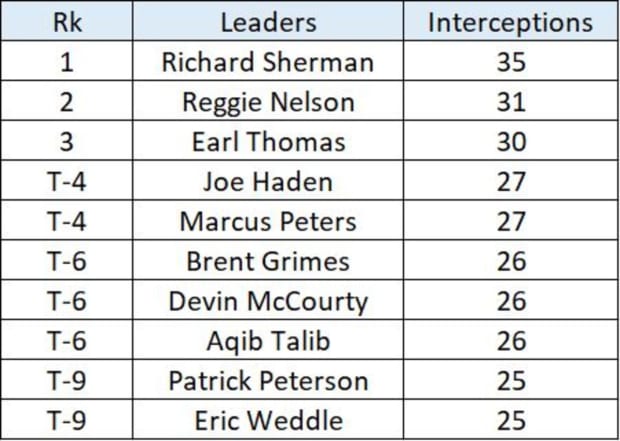
2010s Pick:
Interceptions will be the toughest choice to make. Oftentimes a player will have one or two seasons with a high number, and then teams might go six years without throwing the ball near them. In fact, my initial story last year showed such low numbers in the 2010s that it prompted former MMQB teammate Jonathan Jones to examine the NFL’s shrinking interception rate. Only three players picked off 30 passes last decade and it could be even slimmer pickings (pun very much intended, thank you) in the 2020s.
The selection back in 2010 almost certainly would have been Darrelle Revis, who was coming off his first All-Pro season and received plenty of attention during the first of the Jets’ back-to-back AFC Championship Game appearances under Rex Ryan. His six interceptions were three shy of the NFL lead in 2009 (behind Jairus Byrd, Asante Samuel, Darren Sharper and Charles Woodson, who all had nine), but he was 25 and the best corner in the game. That was the summer his contract holdout was chronicled on Hard Knocks, and he was eventually paid like a star. He had only 15 more in his career though, fewer than Ed Reed had from 2010 until his career ended in 2013 and fewer than the decade total of Luke Kuechly, who was extremely good but was also a linebacker.
2020s Pick:
This is hard to do. No NFL player had more than six picks last year. Only Kyle Fuller and Damontae Kazee reached 10 over the last two years combined. One outlier season or a two-to-three-year peak could swing the whole decade.
If you want an established player, I think the choice is Tre’Davious White, the Bills’ All-Pro corner who had six interceptions last year. He’s 25 this year, and one of just four players 25 or younger with a five-interception season in either of the last two years. The others are Minkah Fitzpatrick, J.C. Jackson, Kevin King and Darius Leonard, who all had five last year. Marshon Lattimore had five as a 21-year old in 2017, but has had just three over the last two years combined, which shows you how hard it can be to pick a player who’ll sustain a stretch with big interception totals. So I’ll take White, with less confidence than I’ve had in any other pick thus far.
Dark horse candidate: This is the ideal spot for a dark horse to actually come out on top, for all the reasons listed above. It’s possible a player will lead the 2020s with something like 30 total interceptions—a peak season with six or seven and then a string of seasons with two or three. So why not try to pick the guy who hasn’t broken out with his peak season yet? Flip a coin for either Jeffrey Okudah, who the Lions drafted third overall, or C.J. Henderson, who the Jaguars took ninth. Then, as with any of your choices, cross your fingers and hope for good health.